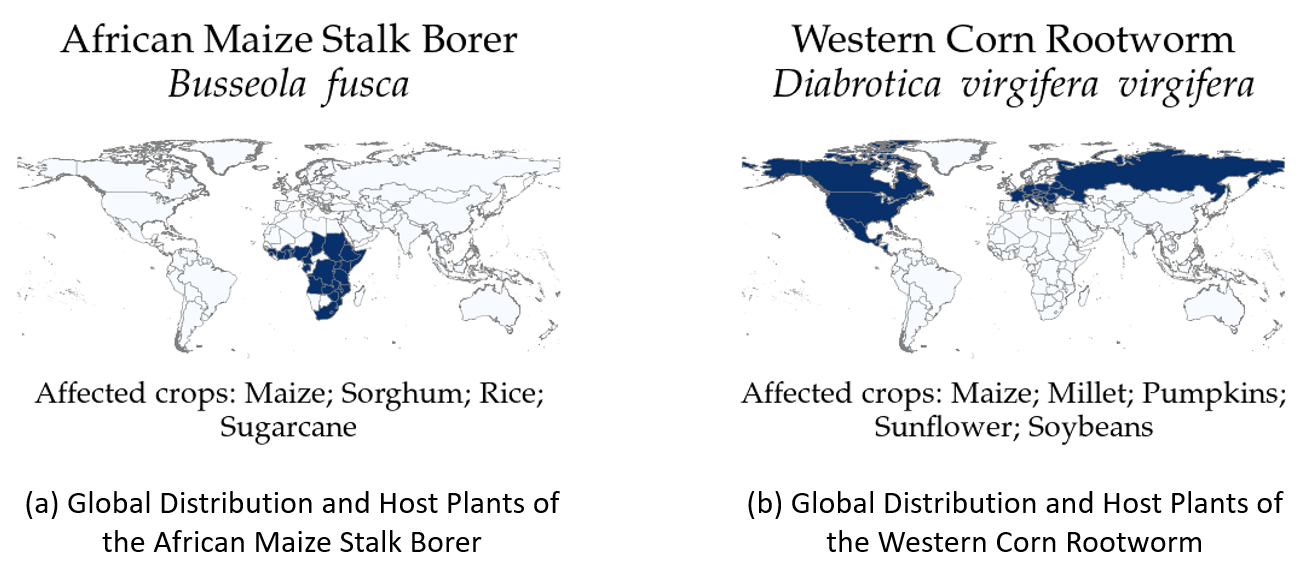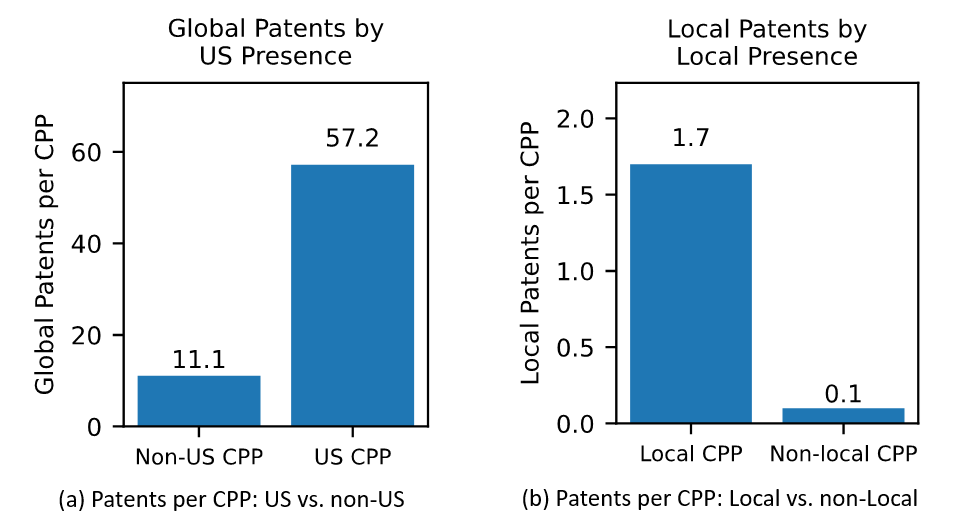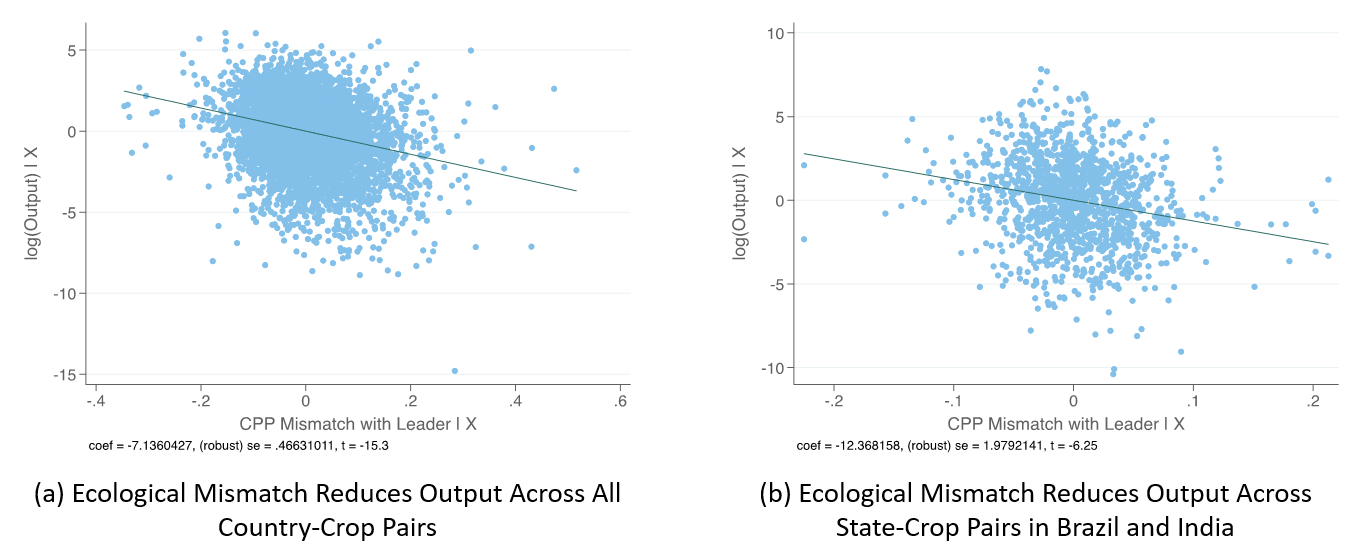
The rich-world bias of agricultural innovation explains a large share of global disparities in technology adoption and agricultural productivity
Agricultural research and development (R&D) is highly concentrated in a handful of rich countries. Fuglie (2016) estimates that 50% of private agricultural R&D occurs in North America. By contrast, a majority of countries in sub-Saharan Africa lack any private-sector breeding programme (Access to Seeds 2019).
An important theory in economics, the Inappropriate Technology Hypothesis, argues that such disparities in research are at the heart of global productivity differences. In short, this theory argues that technologies developed in rich countries are designed to match local conditions and characteristics, and hence are significantly less productive elsewhere in the world (Stewart 1978, Acemoglu and Zilibotti 2001). This technology mismatch causes productivity to persistently differ across contexts and cluster only in places that are “similar” to the high-income countries where research takes place. Despite this theory’s influence, however, we know very little about its quantitative relevance or global incidence. To what extent does the specific focus of innovation underlie the large gaps in productivity and prosperity around the world?
In Moscona and Sastry (2022), we study the inappropriate technology hypothesis in agriculture, a sector in which disparities in global productivity are substantially larger even than those in manufacturing (Caselli 2005). We first show that agricultural technology development is systematically biased toward the ecological conditions of rich countries. We then show that greater ecological mismatch with research-intensive countries substantially reduces the diffusion of modern technology and agricultural output. Thus, technology mismatch substantially limits the potential global impact of innovation and the inappropriate technology mechanism explains a meaningful share of global agricultural productivity differences. These results underscore the central role of incentives in the global innovation system for shaping global productivity, even in the poorest parts of the world.
Agricultural technology is designed for rich-world ecology
An important feature of local ecology that affects agricultural production is the presence of specific crop pests and pathogens (CPPs). Research shows that CPPs reduce global agricultural output by 50-80% (Oerke and Dehne 2004), and developing resistance to CPPs is a key focus of plant breeding (McMullen 1987, Dong and Ronald 2019).
We measure the global range of all known CPPs and the crops that they affect using data from the Centre for Agricultural Bioscience International (CABI). Figure 1 shows two examples out of the almost 5,000 CPPs in our database. The African Maize Stalk Borer and Western Corn Rootworm, two major threats to maize production, are respectively isolated to sub-Saharan African and to North America and Europe, illustrating how different parts of the world face distinct ecological threats.
Figure 1: Global distribution and host plant lists for different pests

Notes: Each sub-figure displays the global distribution and host plant lists for the corresponding pest. The dark countries in the maps are ones in which the pest is known to be present. Data were collected from the Crop Pest Compendium (CPC) published by the Center for Agricultural Biosciences International (CABI).
We show that global innovation focuses systematically on the CPP threats of high-income countries. As one example, a CPP found in the US is, on average, mentioned in 57 agricultural patents filed globally since 2000, while a CPP not found in the US is mentioned in 11. This pattern is driven primarily by local bias–in all countries, a locally present CPP is 17 times more likely to be mentioned in a patent than a non-locally present CPP (Figure 2b). Since rich countries do more R&D, this local bias translates into an aggregate rich-world bias in the ecological conditions that receive the most attention.
Ecological differences impede technology diffusion
Motivated by these results, we develop a data set of CPP Mismatch for all crops and countries. This measure captures the differences in the set of CPP threats for each crop between each country and the country where most technology development for that crop takes place. We then study how disparities in the focus of technology influence global technology diffusion and adoption. In particular, does ecological mismatch with the centres of crop technology development limit technology transfer?
As our main proxy for technology diffusion, we measure the development and international transfer of agricultural biotechnology using data on all instances of intellectual property protection for uniquely identified seed varieties around the world. We constructed this data set using proprietary data from the International Union for the Protection of New Varieties of Plants (UPOV), the organisation tasked with overseeing the global implementation of intellectual property protection for agricultural biotechnology.
Figure 2: The average number of patents per CPP for CPPs present in the US and CPPs not present in the US

Notes: Figure 2(a) reports the average number of patents per CPP for CPPs present in the US and CPPs not present in the US. Figure 2(b) reports the average number of patents per CPP by inventors in a given country when the CPP is also present in the country and the average number of patents when the CPP is not present in the country. CPPs were linked to the full set of biological and chemical agricultural patents by searching for the CPP scientific name in all patent titles and abstracts.
Ecological mismatch substantially inhibits technology transfer: for the median value of CPP mismatch, technology diffusion is reduced by 44%. These results convey that the direction of innovation in research-intensive countries generates technology mismatch – gaps between what technology is designed to do and what it needs to do – which inhibits technology diffusion around the world.
This effect is equally strong for destination countries at all parts of the income distribution, suggesting that, even in the poorest regions, when mismatch is low technology does flow. To make this point even more concrete, we focus on the decisions of smallholder farmers in Africa. Using data from the World Bank’s Integrated Survey of Agriculture from eight African countries, we find that ecological mismatch with frontier innovators predicts significantly less self-reported use of improved seed varieties. While a large body of work has focused on how farmers’ constraints shapes their input adoption, these findings show that another important factor is the nature of technology, which is shaped not by farmers themselves but by innovating firms thousands of miles away.
Technology mismatch as a source of productivity differences
We next study how technology mismatch affects global agricultural productivity. We first find that ecological mismatch severely reduces agricultural production. Across countries and crops, a one standard-deviation change in ecological mismatch predicts a 0.51 standard-deviation reduction in crop-specific output (Figure 3a). The relationship is similar if we focus within two large agricultural economies, Brazil and India, where we find that mismatch lowers crop-specific production in more ecologically mismatched state-crop pairs (Figure 3b).
Figure 3: Ecological mismatch and output

Notes: Figure 3(a) reports a partial correlation plot between log output and CPP mismatch at the crop-by-country level (p<0.01), with crop and country fixed effects partialled out. Figure 3(b) reports a partial correlation plot between log output and CPP mismatch at the crop-by-state level for Brazil and India (p<0.01), with crop-by-country and state fixed effects partialled out.
We combine our empirical estimates with an economic model of global production and directed innovation to quantify how technology mismatch, as we measure it, affects the global distribution of agricultural productivity. Compared to a world with no mismatch, in which research was equally focused on all pest and pathogen threats, agricultural productivity is 58% lower and disparities across countries are 15% higher. Large parts of Africa are most negatively affected.
Broader scope: Future policy, emerging market R&D, and climate change
Our paper focuses on the current state of global innovation and ecological mismatch and shows how the rich-world focus of technology can explain a large share of global agricultural productivity differences. However, several global changes in innovation and in the environment might alter the story in important ways.
One potential driver of future technology mismatch is policy change. The main proposed policy solution to technology mismatch is coordinated investment in R&D outside rich countries. This was a major motivation behind the Green Revolution of the 1960s and 70s, during which international organisations invested substantially in breeding research in specific tropical countries. While the Green Revolution led to dramatic productivity growth in large parts of the world, we show that the productivity benefits were limited in countries with higher ecological mismatch from the specific centres of Green Revolution breeding. For example, large parts of Africa saw little benefit from the Green Revolution because their ecological conditions are distinct from the dominant Green Revolution research centres in India, Mexico, and the Philippines.
More recently, there have been calls for a “Second Green Revolution” that also benefits parts of the world left behind by the first Green Revolution. Using our data, we can identify the locations of crop-specific breeding that could generate new technology with the lowest possible ecological mismatch to the least productive parts of the world.
These results suggest large global benefits to R&D targeted toward several crop-specific environments in sub-Saharan Africa and South Asia, including Nigeria, Tanzania, Zimbabwe, the DRC, Ghana, India, and Pakistan. Rigorous modelling of technology mismatch should be at the centre of any global R&D policy.
A second potential driver of future technology mismatch is the rise of emerging market R&D, most notably in Brazil, Russia, India and China (the BRICs). We find potentially large global benefits from this re-shuffling of technological leadership due to the fact that BRIC ecology is, on average, more similar to low- and middle-income countries than is the current set of technological leaders.
A final potential driver of future technological mismatch is climate change. In other work, we have shown that innovating firms have dramatically shifted their focus toward developing new seed varieties for the crops currently most affected by heat in the US (Moscona and Sastry forthcoming). However, we find no evidence of similar efforts targeting the set of crops that is most affected by heat in low-income countries. This cross-crop mismatch in climate damage layers on top of the ecological mismatch that we describe above, which impedes technology diffusion for a single crop across environments.
At the same time, as the world gets warmer and CPPs migrate poleward (Bebber et al. 2013), high-income countries might inherit some of the CPP threats that currently reside only in low-income countries. This could mean that high- and low-income countries face a more common set of ecological threats, and rich countries face increased incentives to develop technologies to combat threats that had previously been limited to poor countries. We leave a full appraisal of how climate change shifts global ecology, technology mismatch, and productivity to future work.
References
Access to Seeds Foundation (2019), Access to Seeds Index: 2019 Synthesis Report, Accessed from: https://www.accesstoseeds.org/media/publications/.
Acemoglu, D and F Zilibotti (2001), “Productivity differences”, The Quarterly Journal of Economics 116(2): 563-606.
Bebber, D P, M A Ramotowski and S J Gurr (2013), “Crop pests and pathogens move polewards in a warming world”, Nature climate change 3(11): 985-988.
Caselli, F (2005), “Accounting for cross-country income differences”, Handbook of economic growth 1:679-741.
Dong, O X and P C Ronald (2019), “Genetic engineering for disease resistance in plants: recent progress and future perspectives”, Plant physiology 180(1): 26-38.
Fuglie, K (2016), “The growing role of the private sector in agricultural research and development world-wide”, Global food security 10: 29-38.
McMullen, N (1987), Seeds and world agricultural progress, National Planning Association.
Moscona, J and K A Sastry (2022), “Inappropriate technology: Evidence from global agriculture”, Working Paper, Available from: https://papers.ssrn.com/sol3/papers.cfm?abstract_id=3886019.
Moscona, J and K A Sastry (forthcoming), “Does Directed Innovation Mitigate Climate Damage? Evidence from US Agriculture”, The Quarterly Journal of Economics, Available from: https://doi.org/10.1093/qje/qjac039.
Oerke, E C & H W Dehne (2004), “Safeguarding production—losses in major crops and the role of crop protection”, Crop Protection 23(4): 275-285.
Stewart, F (1978), Technology and Underdevelopment, London: MacMillan


